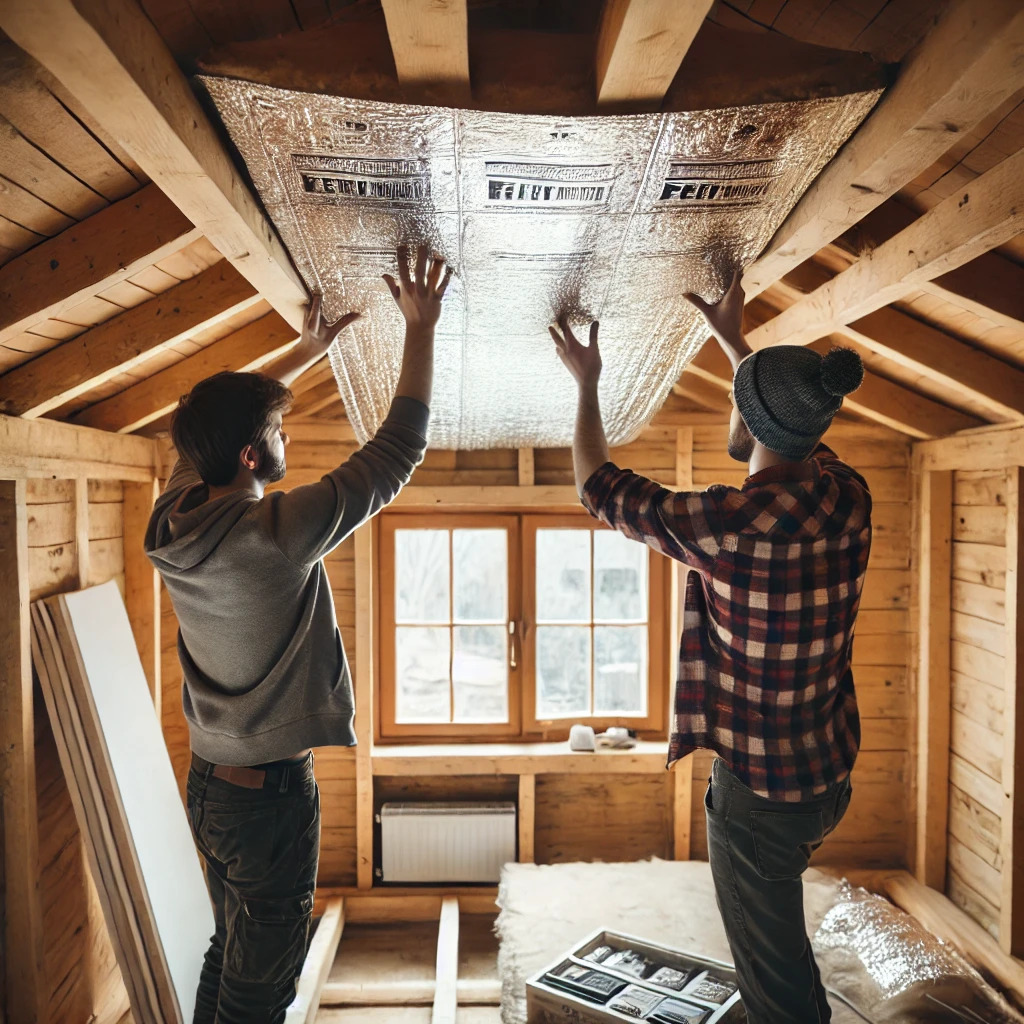How To insulate the Ceiling in the House

Strong 8k brings an ultra-HD IPTV experience to your living room and your pocket.
Houses wear out during operation. The materials used to insulate the roof and ceiling were not designed for long-term use. They shrink and freeze. Performance properties decrease, causing the cold to penetrate inside. Repairs will be required to prevent negative consequences. We will tell you further how and with what to insulate the ceiling in the house.
Why insulate?
Before choosing what to insulate the ceiling in the house with, it is worth understanding why it is necessary. Insulation is done for the following reasons:
- Energy saving – helps reduce heat loss in the home. Good thermal insulation keeps heat inside the premises, which reduces the need for energy for heating and reduces heating costs.
- Improved comfort – the rooms are maintained at a suitable temperature. This is especially important in winter, when the heat energy from the heating systems does not escape through the ceiling. In summer, the layer helps to keep the rooms cool and prevent overheating.
- Preventing the formation of condensation, which contributes to the formation of mold, maintains a dry and healthy microclimate in the room.
- Increasing sound insulation – when choosing the best way to insulate the ceiling of a private house, consider this property. High-quality materials have good sound insulation. The noise level between floors and from external sources is reduced.
- Increased durability of structures – walls and other building elements are protected from sudden temperature fluctuations and humidity. This directly affects their service life.
- Improving overall energy efficiency – protecting the ceiling structure is part of overall energy efficiency measures.
- Increase in the value of real estate - if you correctly understand how to insulate the ceiling in the house and do everything correctly, you will be able to sell the property for more. Potential buyers appreciate energy-efficient solutions that allow you to reduce heating costs.
Additionally, reduced energy consumption due to high-quality insulation leads to reduced emissions of carbon and other pollutants into the atmosphere.
Peculiarities
Before choosing what to insulate the ceiling in the house with and carrying out the main work, find out their volume. This depends on what is above - the attic or the cold attic. In the first case, soundproofing the ceilings between floors may be enough, in the second - full insulation is necessary.
How to insulate buildings taking into account their features:
- Between the beams is a suitable method for attics and lofts.
- On beams, insulation is laid on top and covered with a vapor barrier to prevent moisture from getting in.
- In the attic - on shelves or a slab, which minimizes heat loss.
After choosing what to insulate the ceiling in a private house, you should also install the vapor barrier layer correctly. It is laid on the inside of the room, before finishing the ceiling. It is also important to provide ventilation to prevent moisture accumulation and mold development. Ventilation ducts should be provided to ensure air circulation.
How to insulate the ceiling in the house
Products that can be used to insulate buildings are divided into 4 groups:
- bulk - expanded clay, ecowool, sawdust;
- roll - mineral wool and its derivatives;
- slab - sheets of compacted mineral wool, cork plates, polystyrene foam;
- sprayed - penoizol.
When choosing what to insulate the ceiling in a house, garage, steam room, balcony, etc., you need to know the thermal insulation properties. They are determined taking into account the following factors:
- internal or external installation;
- weather conditions and average annual temperature of the region;
- the need for additional work;
- Insulation execution time and budget.
The combination of these factors will help you understand what is the best way to insulate the ceiling in your home.
How to insulate
Builders use two methods of insulation: from the outside and from the inside. The first method allows you to insulate from above along the ceiling. Any materials are used. The work is carried out quickly. Repair costs are small. The second method comes down to fixing the insulation on the lower plane of the ceiling. It is used if the building has an attic, utilities are laid in the attic, etc. But it is worth seriously thinking about how to insulate the ceiling in a private house from the inside, since bulk materials are not suitable here. You need to buy slabs or rolls. It is also important to follow the installation rules and use high-quality consumables.
How to insulate with sawdust
If you are looking for an inexpensive way to insulate the ceiling of a cold attic, sawdust is ideal. But there are some requirements for it:
- Lack of moisture, otherwise mold will appear - sawdust must be dried beforehand.
- Mixed with fire retardants to reduce flammability.
- Combination with antiseptics, fungicides and slaked lime for protection against mold and rodents.
There are two methods for insulation. The first is mixing sawdust with dry cement and adding a small amount of water. Cement acts as a connector. With the second technology, sawdust is poured in without a connector, but it should be remembered that shrinkage will occur over time.
Pro Tip: Looking for reliable concrete contractors in Guelph? We provide top-notch concrete services for driveways, patios, and more. Contact us today for a free quote!
How to insulate with expanded clay
Expanded clay answers the question of how to insulate the attic ceiling without serious expenses. The material is inexpensive, but has disadvantages:
heavy weight – expanded clay cannot be laid on a thin ceiling system, it is suitable for concrete ceilings;
- low moisture resistance – vapor barrier is mandatory;
- protective layer thickness – from 20 cm.
- To insulate the structure, a mixture of large and small expanded clay is used. All voids are filled in this way. A solution of 5-10 cm thickness is poured on top to protect against moisture and to be able to use the covering as a floor.
How to insulate with ecowool
The product is made from cellulose processing with the addition of boric acid for protection against fungus and a fire retardant for fire resistance. The coating is environmentally friendly and safe. High-quality thermal insulation does not require a large volume of raw materials. The disadvantage of ecowool is its low resistance to moisture and shrinkage, which reduces thermal insulation properties. Installation is impossible without the appropriate equipment. During the work, it is undesirable to lay the material close to the chimney and other sources of thermal exposure. If this cannot be avoided, an additional fence is installed that will reflect the heat.
How to insulate with mineral wool
Mineral wool is inexpensive, has high thermal conductivity and is easy to lay. Shrinkage is 15-20%, so you need to take the raw materials with a reserve. Waterproofing is necessary, since cotton wool absorbs water. It also cannot be crushed, since the properties depend on the air that is between the fibers. Additionally, you will need to lay the outer coating. To properly insulate the structure, wooden logs are pre-installed. They divide the plane into separate sectors and become a support for the flooring.
How to insulate with penoizol
Penoizol can be poured or sprayed onto the surface, but this will require specialized equipment and experience working with it.
Product benefits:
- high-quality insulation;
- filling all cracks and voids;
- harmlessness;
- non-flammability;
- resistance to rodent influence.
The disadvantage of penoizol is its fragility. If damaged, its shape is not restored.
What is better - insulation from the outside or from the inside?
With proper selection of what to insulate the ceiling in the house with and high-quality repairs, each of the methods is reliable. But external work has a minimum of disadvantages compared to internal repairs. Finishing will be required, the height of the ceiling structure is reduced. Also, loose insulation cannot be used, and with a finished repair, the coating will need to be removed. The internal method is suitable for those who are looking for how and what to insulate the ceiling in a cellar, garage or on a balcony, where high-quality finishing touches are not required.
Common mistakes when insulating
In addition to the wrong choice of what is best to insulate the ceiling, many people make mistakes during repairs. The main ones are:
- Incorrect installation – loose or uneven distribution of insulation leads to the appearance of “cold bridges”, which reduce the effectiveness of thermal insulation.
- Ignoring the vapor barrier, which contributes to the wetting of the protective layer, reduces its properties and causes the formation of mold.
- Incorrect placement of ventilation contributes to the accumulation of moisture and deterioration of the protection condition.
- Repairs without sealing joints lead to heat leakage and a decrease in overall work efficiency.
- Incorrect installation of insulation in areas where communications are laid - in addition to making access difficult, this contributes to the appearance of cold zones.
- Laying a layer of the wrong thickness – the size must comply with building codes and climatic conditions. Too thin a coating leads to insufficient thermal insulation. Too thick a layer creates problems for finishing.
- Lack of control over installation, due to which errors were not identified.
- Ignoring design features, which reduces the quality of insulation and contributes to damage to structures.
Some mistakes occur due to lack of experience. If you are not confident in your abilities, it is better to contact professionals. They will qualitatively insulate the object without repeated repairs and additional costs.
Conclusion
We have considered how to insulate the ceiling in a wooden house and other residential and utility buildings. We have analyzed the main repair methods. The decision on which material and method to use depends on many parameters. In order not to make a mistake, you need to consider all the options. This is the only way to properly insulate the object.
Note: IndiBlogHub features both user-submitted and editorial content. We do not verify third-party contributions. Read our Disclaimer and Privacy Policyfor details.


